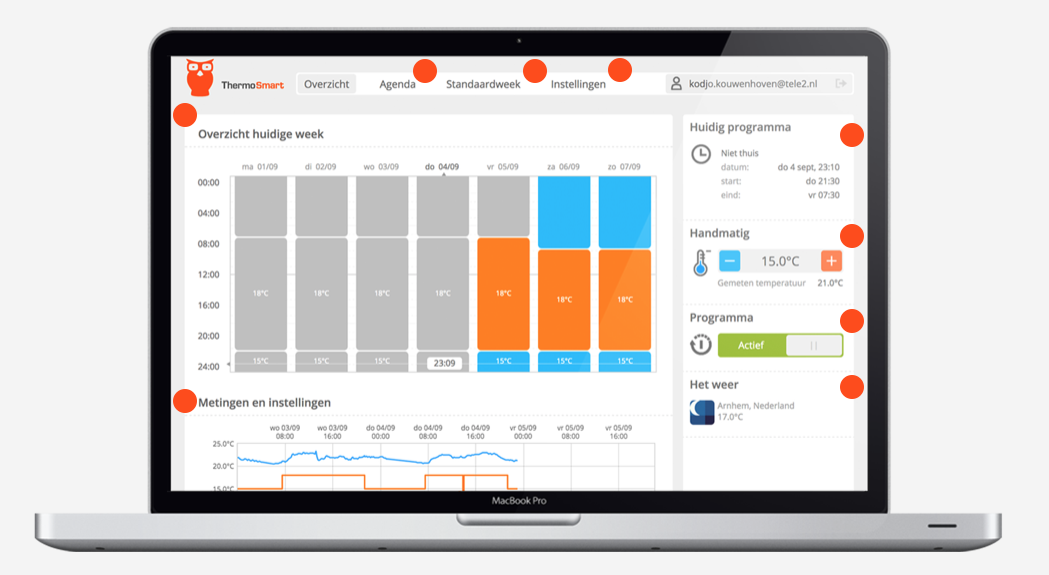
The Arnhem-based company ThermoSmart has developed a smart thermostat that is connected to a software platform. This in turn analyses how energy consumers can use their heating systems such as boilers and heat pumps more efficiently. But who benefits from these savings? The energy supplier or the energy consumer? “We have yet to establish how the savings can best be distributed,” says Ewald Rietberg, CEO of ThermoSmart.

What motivated you to set up ThermoSmart?
“The product was not originally conceived by me, but by the company’s founder, Hans Kouwenhoven (who passed away in 2017, ed.). He wanted a thermostat that consumers could operate more easily and whose design was so good that it wouldn’t look out of place in your living room. At that time, all you really had were Honeywell’s thermostats. They didn’t look so nice. The ThermoSmart basic product and user interface is still based on the original design, which was really impressive.”
Smart meters
“We revised our strategy in 2017. There is now more focus on B2B applications like the provision of services under the ThermoIQ brand. These are based on data generated by ThermoSmart. When you read the smart meter, the ThermoSmart lets you see how much gas and energy you use to heat your tap water, cook and heat your home. This makes it easier to regulate your energy consumption.”
“Installation and service companies can use the data analyses to fine-tune the water heaters they supply. They will also be able to carry out maintenance more efficiently by remotely monitoring these appliances. Energy suppliers can assist their customers by using data analyses to explain to them just how much they can save if they change their heating habits or insulate their homes.”

What has been the biggest obstacle you have had to overcome?
“It’s hard to get a foothold in a market where competition is so massive. Nest is a major competitor. It’s owned by the American company Google. Another rival is the German tado° who are owned by Amazon; another American. They’ve put €100 million into it. Google has invested €3 billion in Nest. Then there’s Honeywell. We bypass these large parties by adapting our thermostats to specific products that supply heat, such as heat pumps and boilers. Tado° and Nest only supply ‘one size fits all’ products. We offer made-to-measure solutions. We can do that because we are small and flexible.”
What has been the biggest breakthrough so far?
“That was when we started taking readings from the smart gas and electricity meters. That allows us to provide consumers with detailed insight into their usage. This tells them, for example, how much it costs when they turn up the heating one degree higher.”
“Another breakthrough is that we can ensure more efficient use of heating by collaborating with installation companies. For example, they can see on the ThermoSmart internet platform that the pilot light in a specific heating unit has to be switched on several times before it actually turns on. The installation company then knows that it needs to be inspected.”
Conserve energy, save on costs
To this end, a trial is currently underway at the Dutch energy supplier Greenchoice . We’re working together with them in conjunction with the Dutch installation company Comfort Partners. We are currently in the process of figuring out how to make our business model profitable. It’s a certainty that our system saves money. We just not sure yet how these savings should be divided amongst the energy consumer and the energy supplier.”
What can we expect from ThermoSmart in the coming year?
“We want to attract funding in order to drive international growth. We plan to do that together with the energy suppliers and installation companies whom we do business with. We’ll connect ThermoSmart to heat pumps, boilers, electric heating and floor heating systems. The ThermoSmart is to get an upgrade with a new Wifi chip. And we’re designing a new ThermoSmart application that will allow you to regulate the temperature in the separate rooms of your home by remote control. The heating valves are controlled by radio and respond to sensors that measure room temperatures.”

Where do you want ThermoSmart to be in 5 years’ time?
“By then we will be selling a lot of ThermoSmarts and have a turnover of €20 million per year. We had a turnover of half a million euros in 2018. We have sold about 12,000 thermostats since our inception. That’s still not enough. Manufacturing the hardware is expensive, but you can make a profit on the software that we sell with it. But that’s only possible if you sell enough thermostats. You need these in order to collect and analyse the data. That’s where we make our money. That’s why companies such as Google and Amazon have entered this market.”
Postscript by Tado (7-2-2020):
Tadoº does not belong to Amazon, but raised a total of $ 50 million in funding in 2018 from Amazon, E.ON, Total Energy Ventures, Energy Innovation Capital, Inven Capital, the European Investment Bank and others. Amazon didn’t invest 100 million in tadoº. The company’s total funding is currently $ 102 million.
Tado ° is by far the most compatible solution in Europe and is able to control almost all heating systems across manufacturers using the most efficient interface. A modulating heating control is possible via tado °, whereby the heating output can be adapted to the actual heat demand and thus the temperature can be reached and maintained efficiently.

